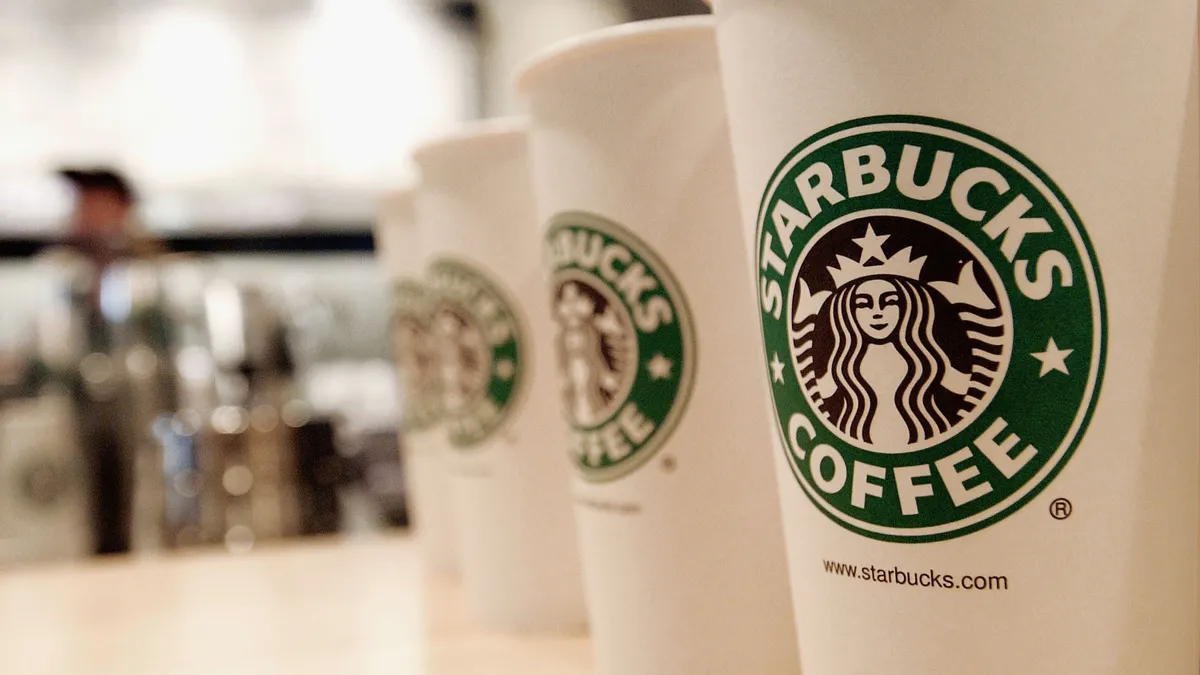Dive Brief:
- Starbucks launched a pilot last quarter where a third-party partner prepared Starbucks orders for delivery offsite between the hours of 5 p.m. and 5 a.m., when the chain’s cafes are traditionally closed, CEO Laxman Narasimhan said last week on an earnings call. During the test, the company “doubled our business,” he said.
- The coffee giant now aims to build a $2 billion business out of this model over the next five years, Narasimhan said.
- Servicing “overnight” delivery orders could offer a path to incremental growth and complement Starbucks’ U.S. delivery business, which saw double-digit increases for both ticket size and total transactions in Q2, Narasimhan said.
Dive Insight:
Starbucks’ pilot has wrapped and the coffee chain is looking to finalize a formal arrangement with a business partner to roll out the service for the long term, a Starbucks spokesperson said.
The coffee chain’s late-night delivery test didn’t extend cafe or barista hours, the spokesperson said. A growing cohort of rival QSRs, however, are launching or extending late-night store hours in a bid to reverse traffic declines — which were particularly acute for Starbucks in its fiscal Q2.
“Following healthy demand over the past three years as the pandemic ebbed, the tide has turned quickly for Starbucks since last fall, with domestic traffic moving from healthy gains as recently as October to choppiness in November and December to -7% in the March quarter—marking the weakest traffic performance at Starbucks outside the pandemic or the Great Recession,” Sharon Zackfia, group head of William Blair’s consumer sector, wrote in a note emailed to Restaurant Dive.
In February, Starbucks announced a delivery pilot with GoPuff to fulfill orders 24 hours a day and deliver them within 30 minutes. At the time, a GoPuff spokesperson said it would soon begin a “Starbucks After Dark” campaign to encourage nighttime orders. The Starbucks spokesperson would not confirm if it is continuing its partnership with GoPuff, or if the pilot between 5 p.m. and 5 a.m. was facilitated by GoPuff.
Zackfia also raised doubts about how effectively Starbucks’ laundry list of turnaround initiatives, including the overnight delivery, could improve its performance.
“The significant reversal of fortune for Starbucks begs the question of whether bigger—and tougher—issues are afoot such as if the company has overreached on price or if the brand’s appeal has lost some of its luster,” she said.
Reduced frequency of occasional customers in the afternoon and evening was a particular problem for the coffee giant in Q2. Narasimhan pointed to “economic pressure” as the cause for weakened engagement with this cohort. Starbucks said it would focus on innovation and faster deployment of new concepts to solve for the afternoon slump, but didn’t mention if it will take a similar approach to product experimentation for future late-night service.
Rival QSRs are rolling out handheld, snackable items to encourage on-the-go diners to visit outside of traditional meal times, especially in the late evening.
Wendy’s extended store hours into the late evening at many of its locations last year to capture growing visits and double-digit sales growth during the daypart.
Pizza Hut has also stretched its operating hours into the early morning — as of October, more than 130 units are open until 2 a.m. on Fridays and Saturdays. Roughly two-third of the chain’s domestic restaurants are open until midnight on Fridays and Saturdays, and 36% operate until midnight seven days per week.
Taco Bell saw such strong late-night traffic gains last year that it spurred the chain to create a new version of its Go Mobile store prototype. The model features a walk-up window for digital and delivery orders to support the drive-thru lane when dining rooms are closed for the night.










